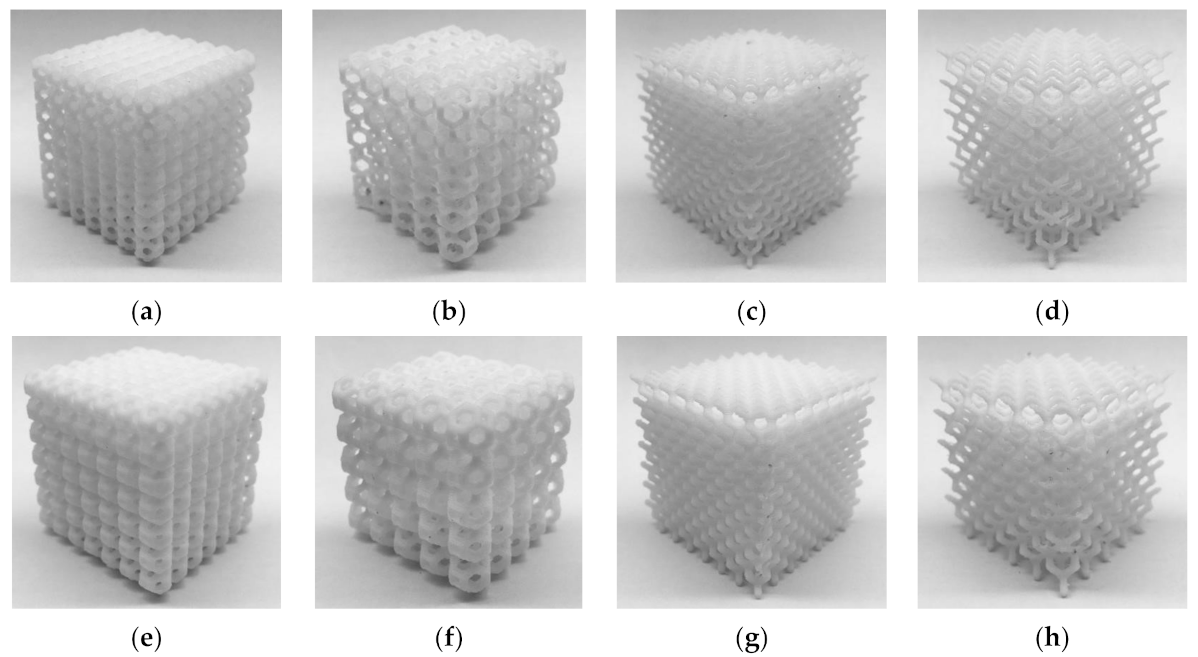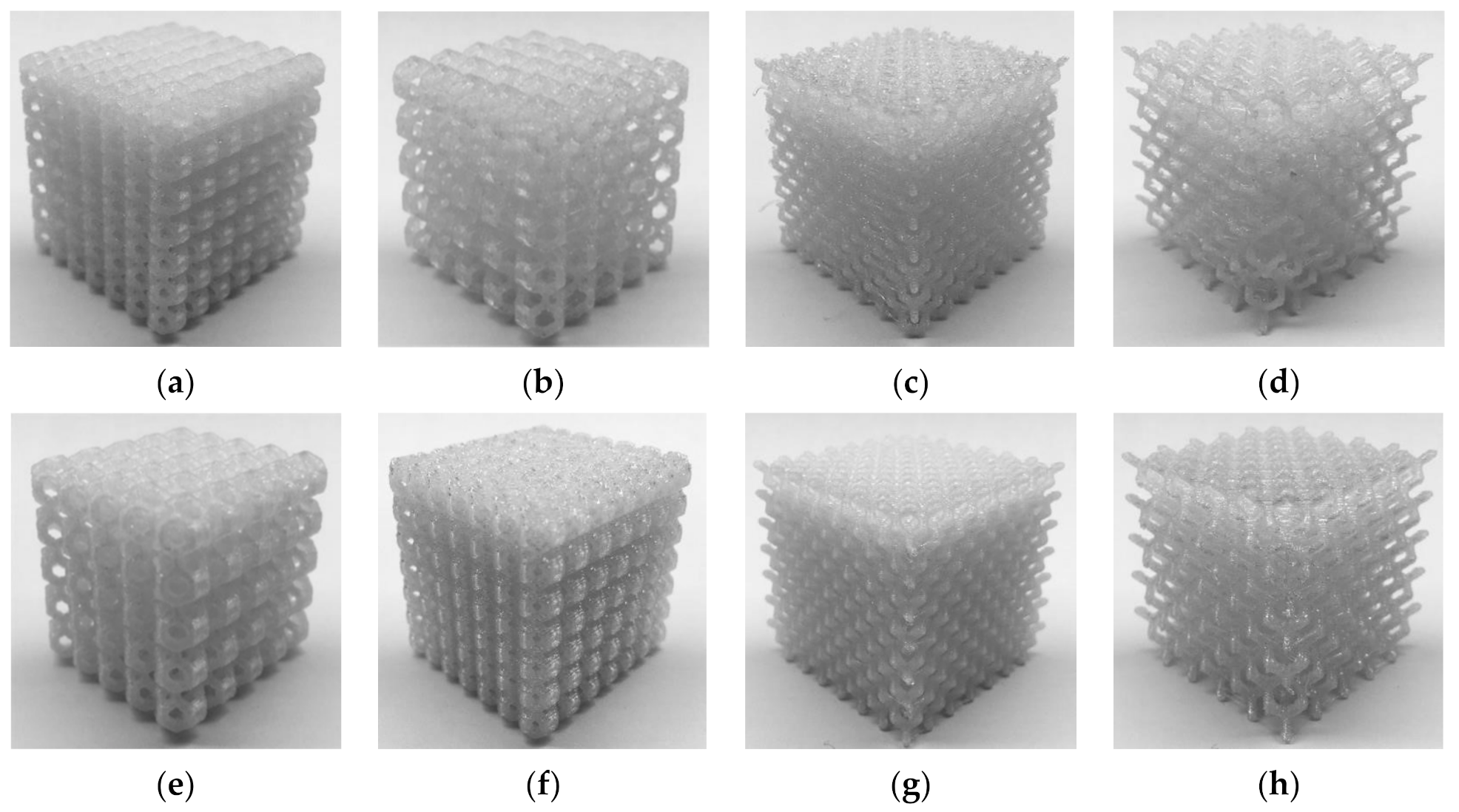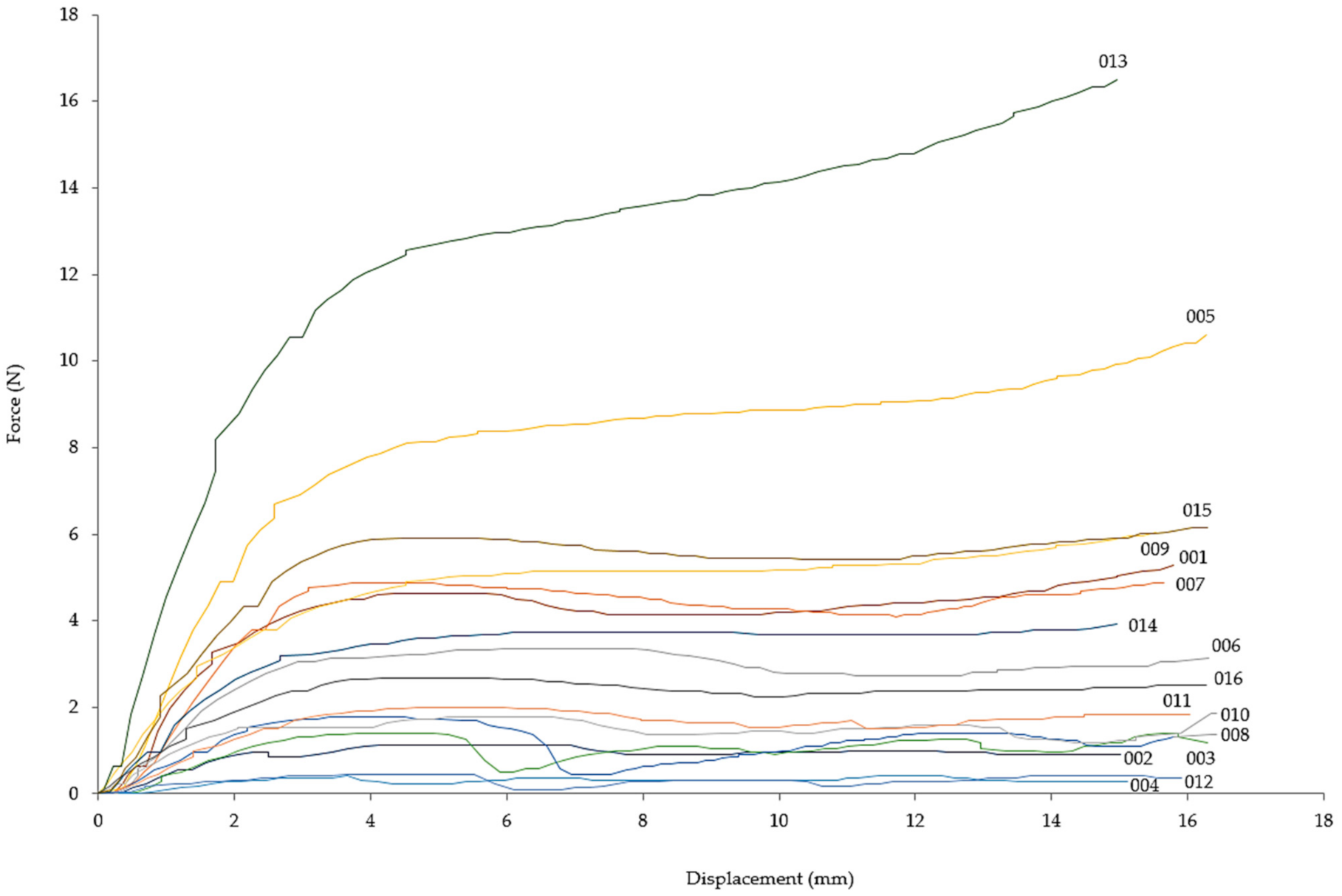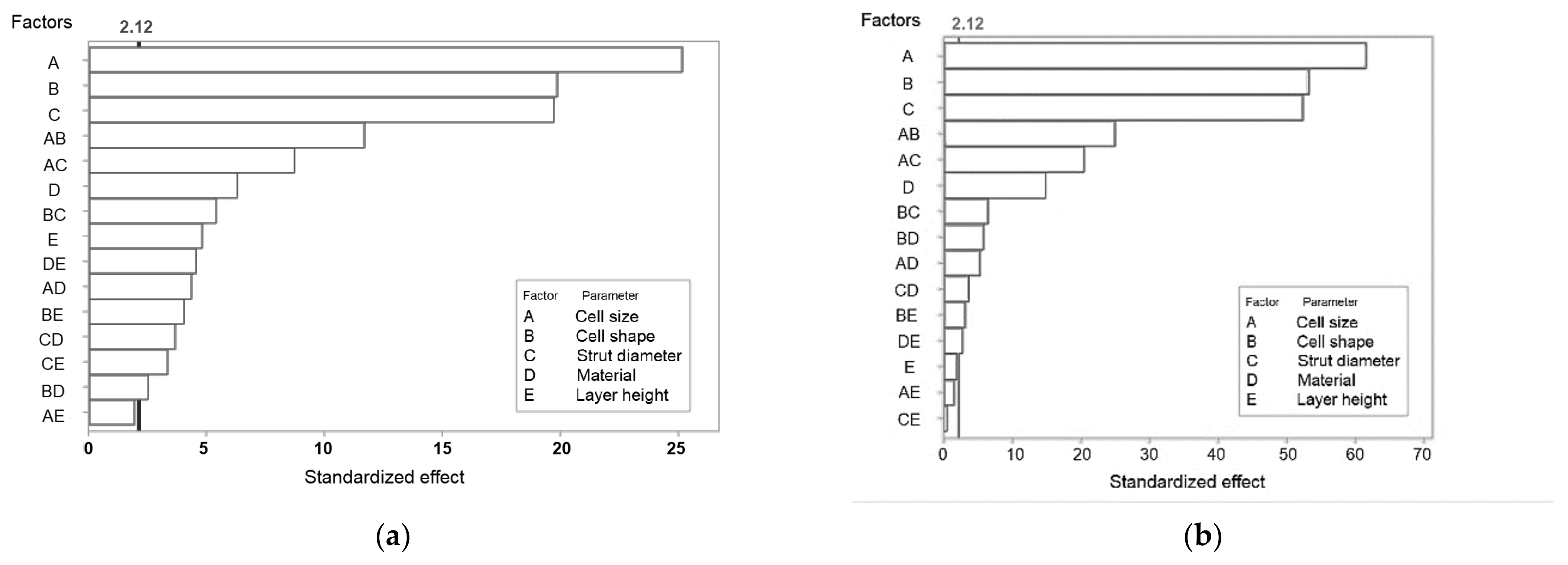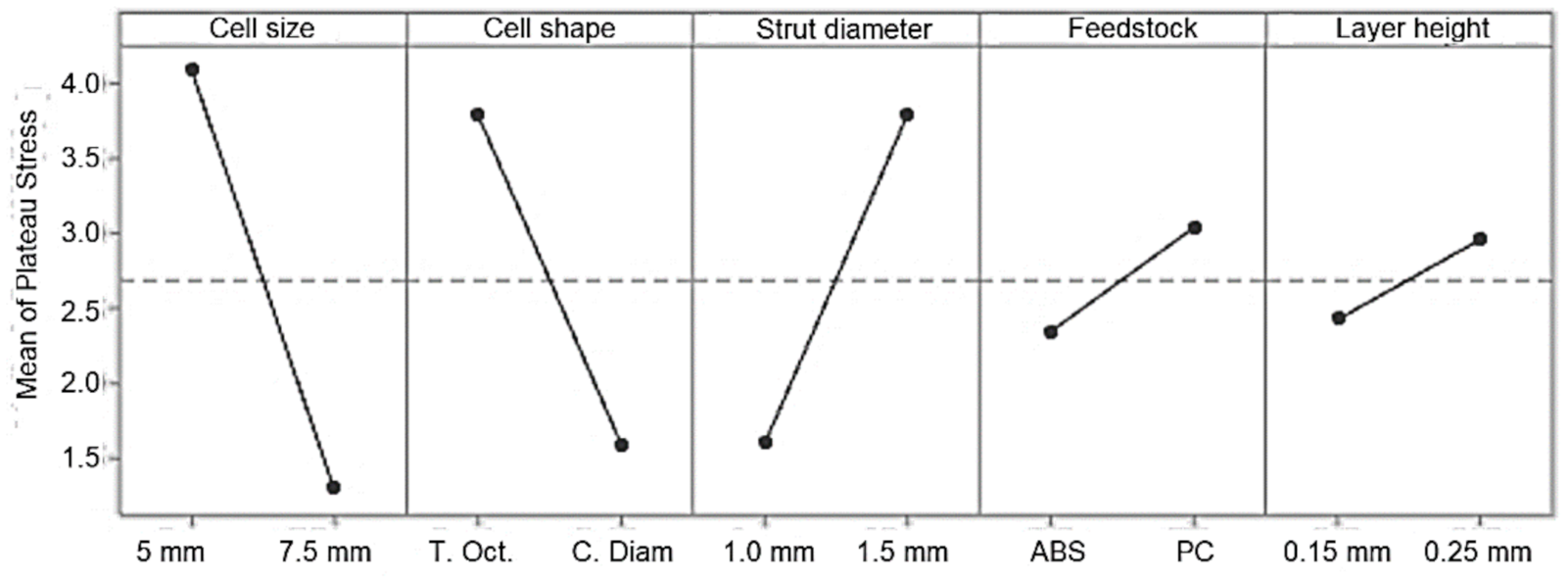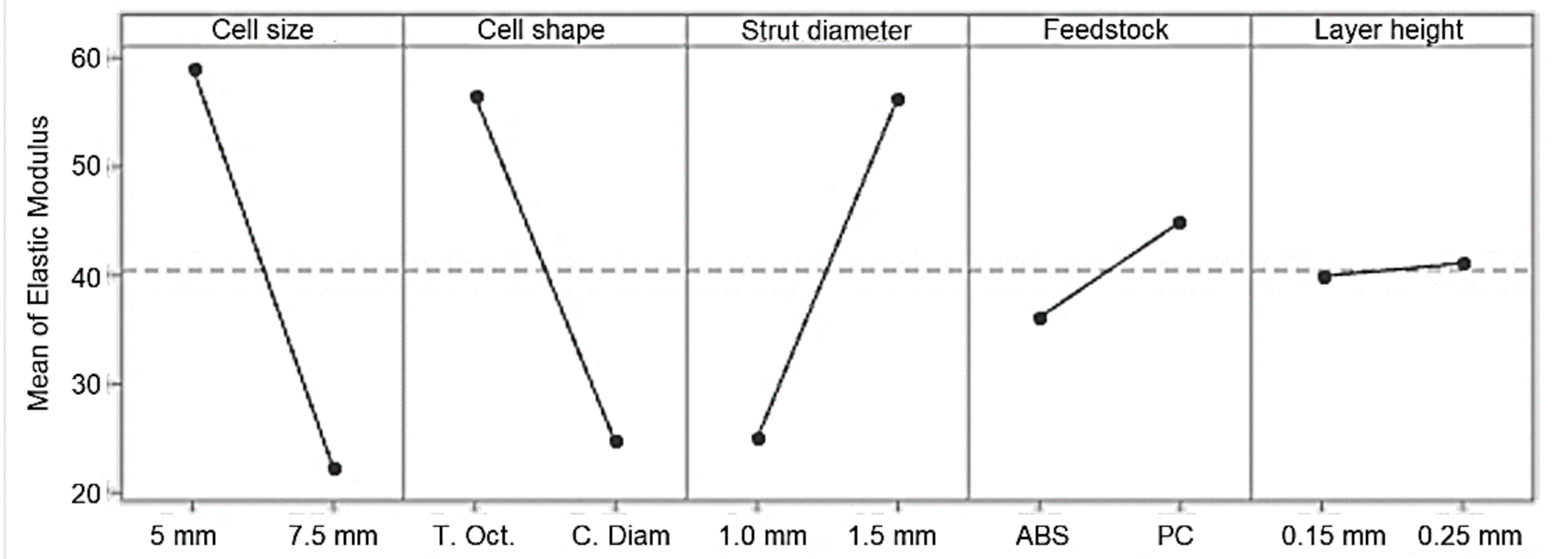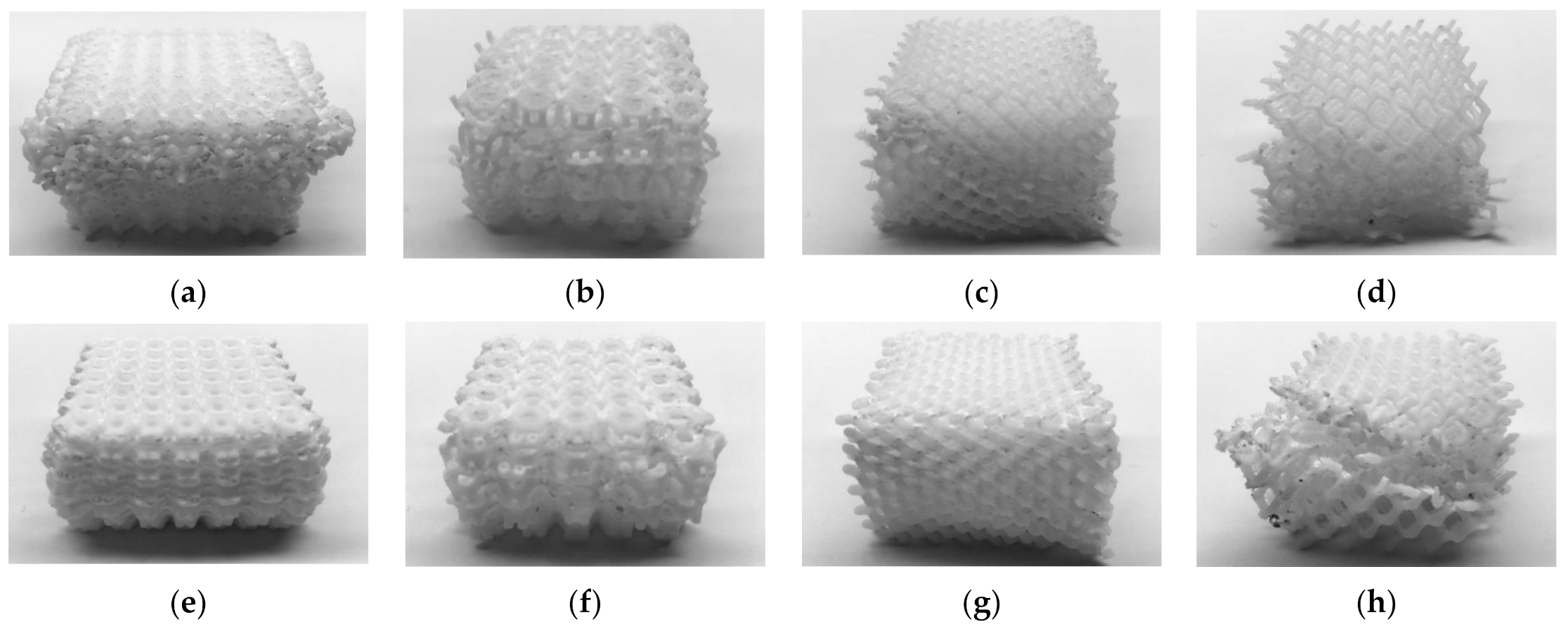1. Introduction
Additive manufacturing (AM) opens up new opportunities for the development of novel materials, as they are capable of generating complex custom-made lattice structures in three-dimensions with precise control over the size and shape of both cells and struts, and the overall topology of the structure [
1]. Applications of lattices include bioengineering devices [
2], acoustics [
3], thermal management [
4,
5,
6], and energy absorption in personal and sports protective equipment [
7].
In recent years, the design, simulation and fabrication of lattices built via AM have attracted attention, and different methods have been proposed to predict the mechanical performance of lattice structures [
8]. However, some design issues like the selection of the unit cell type and its optimal parameters are still open questions [
9].
Thus, the characterization of a multitude of lattice configurations manufactured using diverse AM methods such as fused deposition modeling [
7,
10,
11,
12,
13], stereolithography [
14,
15,
16], jet fusion [
17,
18,
19], and selective laser sintering [
20,
21] is currently a very active topic in research, in addition to the development of diverse analytical and numerical methods for the design of lattice structures [
22,
23,
24,
25].
The influence of diverse geometric parameters (unit cell type, cell size, cell orientation, strut thickness, strut cross-section, etc.) on the mechanical properties of lattice structures has been investigated by analytical, numerical, and experimental techniques [
7,
26,
27,
28,
29,
30,
31]. For instance, scaling law models have been used to model the relationship between strut diameter, cell size, and mechanical properties [
22,
28], and have been validated experimentally [
7,
29,
30,
31].
Experimental studies of FDM-fabricated lattices in particular have been scarce, as alternative AM methods offer better accuracy and quality [
18,
32]. However, the use of FDM could be effective in the production of functional self-supporting miniature lattice structures with a wide variety of unit cell types [
13].
A handful of studies have explored the effect of geometric features in FDM-fabricated lattices. Al Rifaie et al. [
12] compared the compressive behavior of four types of body-centered cubic lattices manufactured using FDM. Stiffness, failure loads, and energy absorption capacity under quasi-static compression were reported, recognizing the influence of vertical support struts on the mechanical properties of lattice structures. Similarly, Karamooz Ravari et al. [
10] manufactured and tested body-centered cubic lattices. The results of compressive tests were compared to analytical and finite element models, confirming that strut irregularities related to the manufacturing process lead to lower mechanical properties of polymer lattice structures built by FDM compared to analytical and numerical predictions. Rossiter et al. [
7] evaluated the effect of five geometric design variables (cell size, strut cross-section shape and area, cell arrangement, and strut filleting), on the compressive behavior of truncated octahedron lattices manufactured by FDM. The factorial design of experiments was used to study the influence of the variables and their interactions, evidencing that strut thickness and cell width had the largest effect on the plateau stress and energy absorption capacity. Guerra et al. [
13] characterized the compressive behavior of diverse miniature lattice structures fabricated by FDM. Although the role of both hardware and software in the mechanical strength of the lattices was discussed, the influence of specific manufacturing parameters on the mechanical properties was not explored.
One distinctive feature of AM-fabricated miniature lattices is the presence of irregularities in struts, which affect their effective mechanical properties [
23,
33,
34,
35]. Although several studies have considered methods to predict the effect of strut irregularities on the mechanical response of lattices [
30,
36,
37], they are considered an unavoidable consequence of the AM processes. Although irregularities have been loosely connected to process parameters in AM-fabricated metal lattices [
38] and some manufacturability issues regarding layer thickness have been discussed [
13,
39], little attention has been given to a possible relationship between the AM process parameters and these irregularities. Furthermore, research on the effects of AM process parameters on the mechanical response of lattice structure has been scarce or addressed only indirectly. Harrysson et al. [
38] considered the staircase effect in lattices manufactured by electron-beam melting but did not establish a relationship between AM process parameters and mechanical properties of lattices. Yan et al. [
29] discussed the causes of irregular struts in metal lattices fabricated using selective laser melting, suggesting that laser melting depth, a process parameter that determines the depth of laser melting into the powder, could play a role in the overall quality of the lattice structure. Cahill et al. [
40] evaluated the effect of part orientation in the SLS fabrication of polyamide miniature lattices (cell size ~2.5 mm), reporting a significantly larger compressive strength in the z-direction.
Regarding FDM-fabricated lattices, research is also very limited. Gautam et al. [
11] evaluated the compressive performance of large FDM-fabricated acrylonitrile butadiene styrene (ABS) single Kagome truss unit cells (cell size 35 mm), reporting a variation of approximately 20% in the compressive strength of the lattices when either build orientation or surface roughness were modified. No research has been presented dealing with the effects of AM process parameters on the mechanical properties of FDM-fabricated miniature lattices (cell size < 5 mm/strut diameter < 1 mm).
On the other hand, the influence of FDM process parameters on the mechanical properties of solid polymer specimens has been extensively studied [
41,
42,
43,
44,
45,
46,
47]. The most common FDM process parameters that can be controlled include layer thickness, build orientation, raster angle, and infill density. Layer thickness is defined as the height of deposited slices. Build orientation is defined according to the position of the part (horizontally or vertically) in the printing bed [
45]. Raster width is the thickness of the extrudate deposited by the nozzle. Raster angle (or raster orientation) refers to the direction of the raster relative to the bed [
48]. Other FDM process parameters include nozzle diameter, flow rate, deposition speed, raster pattern, air gaps (raster to raster, perimeter to raster), number of contours/perimeters (contour width), top thickness, and bottom thickness [
45].
The most important parameters influencing the mechanical properties of FDM parts that should be considered include raster-to-raster air gap, raster angle, layer thickness, infill density, and build orientation [
41]. Other factors such as build orientation and layer thickness also affect the strength and durability of components produced by FDM [
41]. Similarly, process parameters like air gap and raster orientation significantly affect the strength of FDM processed parts, while other parameters such as raster width and extrusion temperature have little effect [
48]. The extrusion temperature does not affect the mechanical properties significantly, as long as the filament is heated enough to be extruded properly [
49]. On the other hand, variations in the envelope temperature–defined as the environmental temperature surrounding the FDM process–could have strong effects on the mechanical properties of parts [
48].
In the present work, the compressive behavior of two miniature lattice structures, the truncated octahedron and cubic diamond, is analyzed to evaluate the effect of geometric and manufacturing parameters on their mechanical properties. Additionally, multilinear regression models derived from experimental data are presented for the prediction of the plateau stress and elastic modulus.
3. Results
Figure 3 shows the force-displacement curves for compression tests of the 16 lattice configurations. The region of densification that commonly follows the plateau is not depicted, as the compression tests ended at around 45–50% nominal strain, before reaching densification strain. The broad range of curves reveals the overall effect of the variation of the parameters on their compressive response, with compressive forces ranging from 0.1 to 15 kN, although most lattices were in the range of 0.1–5.0 kN.
Mean values and standard deviations for the elastic modulus, plateau stress, and energy absorption capacity for the 16 lattice configurations are presented in
Table 5. The energy absorption capacity quantified in
Table 5 was measured as the area under the stress-strain curve up to a value of 40% nominal strain.
In some lattices, the standard deviation of the elastic modulus was noticeably larger, a consequence of small variations in the compressive force related to the non-homogeneous stress distribution inside the lattices during the test. To adjust for these oscillations, three measurements of the elastic modulus along different sections of the elastic region of the curve were made and then averaged.
Minitab 19 was used for the statistical analysis. Energy absorption capacity was not included in the analysis, as it is a direct outcome of the plateau stress.
Pareto plots were constructed for both plateau stress and elastic modulus (
Figure 4). The bars that represent factors and interactions that cross the reference line at 2.12 are statistically significant at the 0.05 level. Both graphs show that factors A, B, and C, i.e., cell geometry parameters, are the most important factors defining the mechanical response. Interaction AB and AC are also important, showing a stronger influence than parameters D (feedstock material) and E (layer thickness).
Figure 5 shows the normal probability plot of effects for plateau stress and elastic modulus. The plots depict the magnitude, direction, and importance of every factor and interaction: those effects that are further from 0 are statistically significant at the 0.05 level. For both plateau stress and elastic modulus, the main effects for all factors (A, B, C, D, and E) are statistically significant.
The plot also indicates the direction of the effect. Cell size (A) and cell shape/type (B) have a negative standardized effect, i.e., a change from the low level to the high level of the factor causes a decrease in response. On the other hand, factors C, D, and E have positive standardized effects, so a change from the low to the high in any of them increases the outcome values.
Main effects plots are presented to compare the relative strength of the effects of the five factors on the plateau stress and elastic modulus (
Figure 6 and
Figure 7). Factors with a larger slope have a bigger impact on the mechanical properties. Thus, geometric parameters (cell shape/type, cell size and strut diameter) have the largest influence on plateau stress and elastic modulus, while the effect of feedstock material and layer thickness/height is much smaller. Factor A and B at the low level (cell size 5 mm, truncated octahedron) and C, D and E at the high level (strut thickness 1.5 mm, PC and layer height 0.25 mm) yield maximum mechanical properties. The main effect values for both plateau stress and elastic modulus are shown in
Table 6 and
Table 7.
Another way to describe the main and interaction effects for two-level designs is using a regression model [
55]. Excluding the least significant parameters, a model for plateau stress was obtained
and similarly, a reduced model for elastic modulus
Table 6 shows the coefficient values for the regression model for the plateau stress. All p values are 0.05 or less, confirming that all variables have some degree of influence on the response with a 95% confidence. Similarly,
Table 7 shows the coefficient values for the regression model for the elastic modulus. The results were statistically significant for all factors (
p < 0.05), except for layer height (
p = 0.062), cell size × layer height (
p = 0.126), and strut diameter × layer height (
p = 0.595).
Deformed specimens for every lattice are presented in
Figure 8 and
Figure 9. Barreling is noticeable in the compressed specimens of the two strongest lattice structures, 005 and 013 (
Figure 8e and
Figure 9e). The barreling could be attributed to the friction between specimens and the machine plates and is similar to the response of homogeneous materials. All specimens showed signs of damage localization. This behavior is consistent with the mechanical response of porous materials under compression, in which deformation is associated with strain localization, typically in the form of bands [
64,
65], which determine the onset of yielding, hardening, and the level of plateau stress [
66].
In some cases, the localization was visible in the form of horizontal localization bands, i.e., crushed layers of cells (
Figure 8a,b). In those samples, the plastic collapse of the structure took place on a layer-by-layer basis, with minimal (
Figure 8b,e) or localized (
Figure 8d) variations in its cross-section. In other materials, the localization took place along the diagonal of the specimen, leading in some cases to the fracture of the specimen (
Figure 8a and
Figure 9a). The width of the diagonal localization band was close to the cell size. Similar patterns were reported for octet-truss (or face-centered cubic) and truncated octahedron lattice materials manufactured by other AM methods [
58,
67,
68].
4. Discussion
Although the manufacturing of small geometric features pushes FDM to its practical limits, variations in the mechanical response among the first and second samples of the same lattice were negligible in all but two cases (014 and 016), reflecting a good consistency in the manufacturing process. The two failed samples were discarded (according to standard ASTM D1621) and replaced by new specimens. While the new 016 specimen showed the expected behavior, the new sample of lattice 014 failed to reach the maximum value of plateau stress, as evidenced by the large standard deviation in plateau stress (
Table 5). This scattering of mechanical properties was specific to lattice 014. A direct comparison with lattice 006, which has the same geometry as lattice 014, eliminates this as a possible explanation, which leads to assuming that the effect of manufacturing parameters (feedstock material and layer thickness)—or a superposition of multiple factors—could be the cause of the poor repeatability.
Some materials showed significant fluctuations in strength during the compressive test (
Figure 3). In some cases, the fluctuation was present as a sudden decline, such as in lattices 003 (1.36 to 0.31 kN), 008 (1.36 to 0.45 kN), and 012 (0.45 to 0.09 kN). Although strain localization bands are visible in the compressed specimens (
Figure 8c,h and
Figure 9c,d), they are also visible in the other cubic diamond lattices that did not experience a sudden decline. Nevertheless, it is noteworthy that the reduction of strength arose when the displacement was about 5–7 mm, similar to the cell size in the lattices.
The best mechanical properties were obtained for specimens 013 and 005, with both structures having identical cell size (5 mm), unit cell type (truncated octahedron), and strut thickness (1.5 mm). On the other hand, the poorest mechanical response was obtained by structures 004 and 012, both having the same cell size (7 mm), unit cell type (cubic diamond), and strut thickness (1 mm).
The energy absorption capacity of lattices 005 and 013 was 4.25 MJ/m
3 and 3.05 MJ/m
3, respectively, which is significantly larger than values reported earlier for polymer lattice structures with larger cells [
7]. The energy absorption capacity of specimens 005 and 013 was similar to that reported for titanium truncated octahedron lattices with over 80% porosity (1.6–6.5 MJ/m
3) [
58], thus evidencing potential for energy absorbing applications.
The influence of all five parameters on the compressive response of the cellular structures was statistically significant. The statistical analysis confirms that cell size and strut thickness influence the plateau stress of lattice structures. This outcome is consistent with previous studies that explored the influence of cell size and strut diameter on the mechanical response of lattices [
7,
28,
29,
30,
31]. The strength and modulus of the lattices increased with the decrease in the unit cell size and/or increase in strut diameter, due to the associated denser structures [
29]. Similarly, the analysis also confirms the results of previous studies that explored the mechanical response of both unit cell types [
24,
57,
58]: truncated octahedron lattices showed better mechanical properties compared to cubic diamond lattices.
On the other hand, feedstock material and layer thickness played a secondary role, with PC and a larger layer thickness associated with better mechanical properties. This contravenes previous studies that reported a strong influence of layer thickness on the properties of FDM-fabricated solid parts [
41]. Furthermore, this also suggests that the effect of strut irregularities, and its subsequent effect on the mechanical properties of miniature lattices, might not be greatly reduced by the minimization of the layer thickness.
The effect of feedstock material, although statistically significant, is secondary when compared to the geometrical parameters. Given that both the density and the moduli of both feedstock materials are similar (
Table 1), a lesser effect on the elastic modulus was expected, as suggested by available scaling law models [
22,
28]. On the other hand, the compressive yield strength of solid PC doubles that of ABS, which should produce a large difference in plateau stress of lattice built using different feedstock material [
22]. Nevertheless, the effect of feedstock on the plateau stress does not reflect this assumption. Given the wide variation in mechanical properties reported in the literature for these two materials [
69], further analysis of this topic is necessary. Thus, additional compression tests under ASTM D695 were carried out for solid ABS and PC specimens built using FDM, showing similar yield stress values for both ABS and PC (40.99 MPa and 43.21 MPa, respectively).
Among the five parameters, layer thickness had the least influence on the mechanical response. Although layer thickness affects the strength and durability of solid FDM parts [
41], its influence in FDM-fabricated lattices seems to play a secondary role. Given that manufacturing cost is directly related to layer thickness [
43], it would be cost-effective to use the largest possible layer thickness. For instance, an increase in layer thickness from 0.15 to 0.25 mm would represent a 50% reduction in printing time.
The multilinear regression models (Equations (1) and (2)) could be used to determine the approximate variation of plateau stress and elastic modulus when one or multiple parameters are varied.
Table 8 presents the variation in mechanical properties when single parameters are varied from high to low level. While a change in a single geometric parameter can produce a strong decrease in mechanical properties, a change in feedstock material or layer thickness causes a smaller effect. On the other hand, the influence of layer thickness on elastic modulus is marginal.
An analysis of variance was performed to assess the data and regression models. The p-values for all the main factors were statistically significant (0.05 or less), demonstrating that all parameters are relevant. The R2 value for both models is over 99.4%, which indicates that the models fit the data very well. The variance inflation factors are small, which evidenced that the factors were not correlated.
In contrast to analytical and numerical models, which overpredict the effective modulus [
23], and semi-empirical methods based on the scaling law, which do not address geometric details of the lattices explicitly [
9], the current approach could be used for the design of lattice structures with specific mechanical properties. Although limited in scope, the models are very accurate, and the parameters could be fine-tuned to obtain specific mechanical properties such as a set value elastic modulus, plateau stress, or even energy absorption capacity.
5. Conclusions
In this study, the effects on the compressive response of 3D printed miniature lattice structure of five factors were examined.
All tested parameters were found to have significant effects on the mechanical properties of the lattice structures. Cell geometry (i.e., unit cell type, cell size and strut diameter) was shown to have the largest effect on the mechanical response of the lattice structures, represented by the plateau stress and elastic modulus. On the other hand, feedstock material and layer thickness have significant effects on plateau stress, but its influence is minor when compared to the geometric parameters. Regarding the elastic modulus, layer height had no significant effect. This last observation goes against our current understanding of the effect of layer thickness on the mechanical properties of solid FDM fabricated parts.
Unit cell type, cell size, and strut diameter define the relative density, which determines the mechanical properties. Hence, a smaller cell size, a truncated octahedral cell, and thicker struts increase the density, and subsequently the mechanical properties of the cellular materials. Results also suggest that polymer truncated octahedron lattices have potential in protective applications, with an energy absorption capacity similar to that of high porosity metal foams, although further analysis is required.
Although the accuracy of the manufacturing process is limited, FDM could be a simple, cost-effective method for the fabrication of custom-made 3D lattice structures. Factorial design models, although limited in scope, could be an effective tool in the early stages of design of customized lattice structures.
